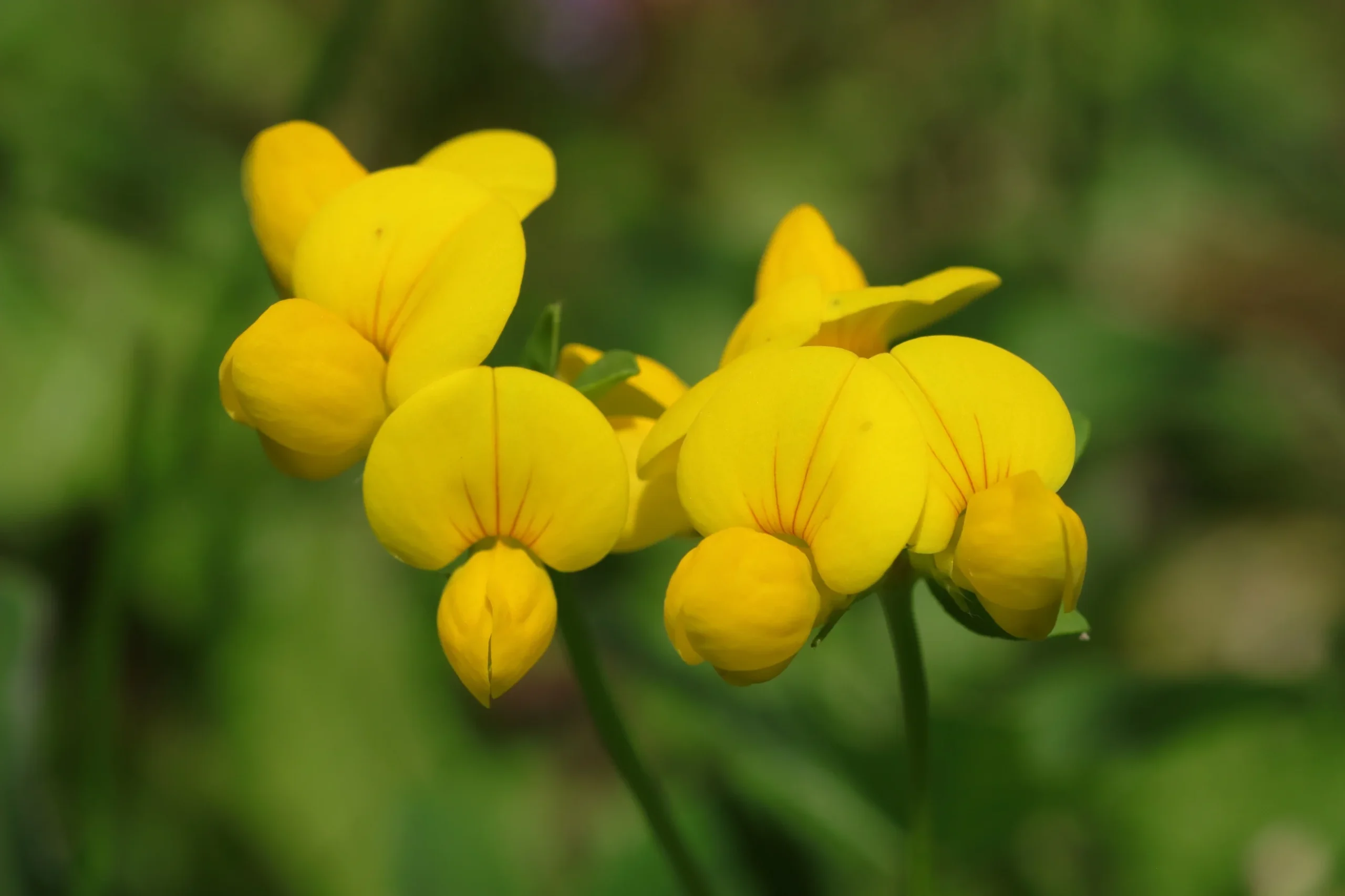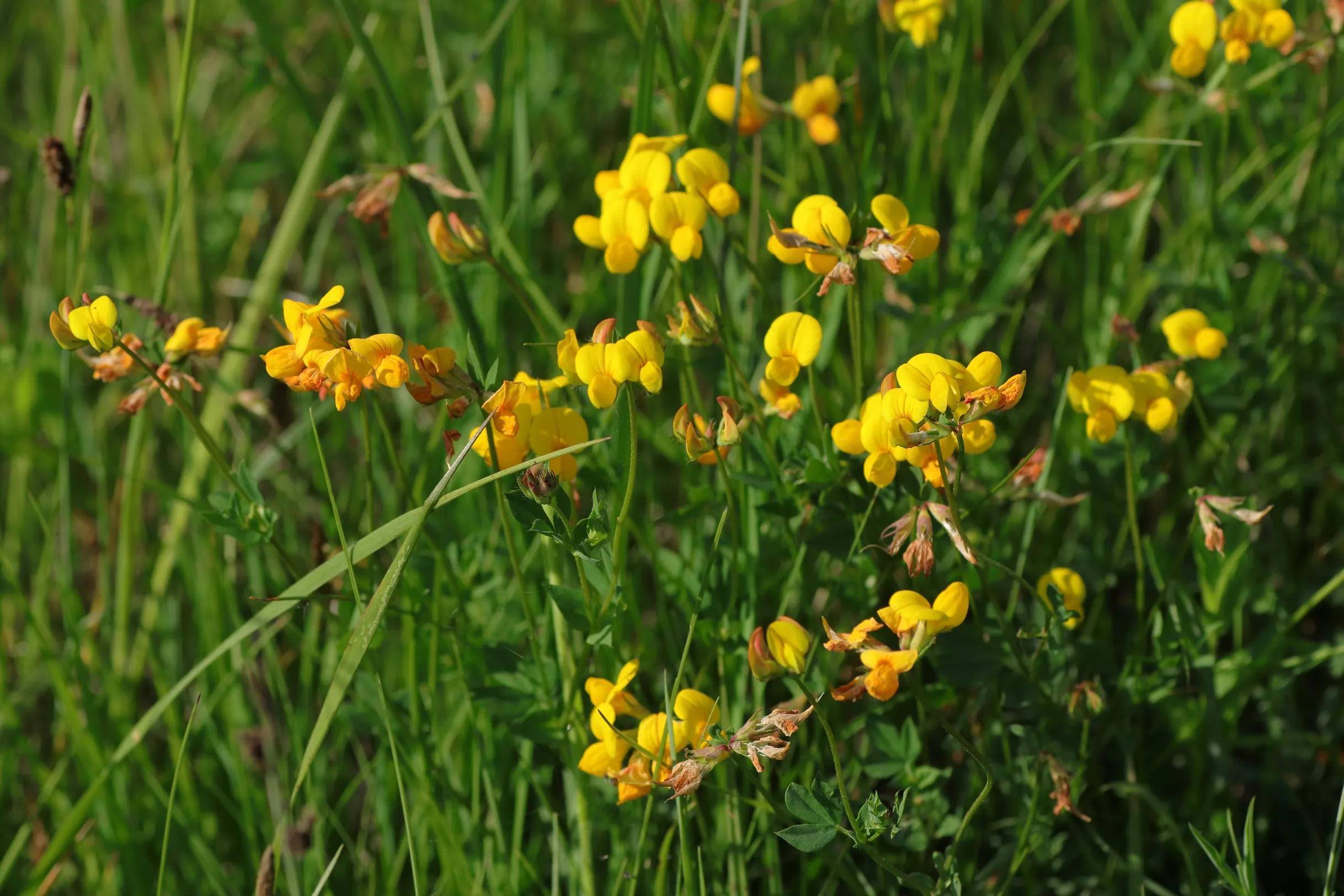In Latin, the common Bird’s-foot trefoil is known as “Lotus”, as are all other species of bloomfell. However, our native plant has no relation to the “lotus – water lily” (Nelumbo).


Occurrence and distribution: Bird’s-foot trefoil has adapted to a wide range of climatic conditions. It can be found in almost all of Europe. The plant prefers meadows, pastures and roadsides. It is also often found in our gardens and in other man-made places such as warm quarries. The plant likes an acidic, loamy soil. It prefers a sunny location. In the Alps, the plant can be found at an altitude of up to 2,000 metres.
Plant description
Growth habit: This is a hardy, perennial herbaceous plant. It can reach a height between 5 and 30 cm (rarely higher specimens are found). The plant has a carpet-like growth habit and forms elongated, above-ground runners. Roots can reach a depth of up to one metre. The flower clusters form at the end of the green, richly branched stems.
Leaves: Five-pinnate leaves form at the base of the stem. The individual leaves are ovate to roundish in shape. The ends of the leaves may converge in a point. Three green coloured bracts form in a whorl under the inflorescences. All leaves have a green colouring on the upper side and a slightly grey colour on the lower side.
Flowers: 3 to 10 flowers grow from the stems in umbels. The individual flowers have a golden yellow colour and are zygomorphic. Lower petals are slightly rolled up into each other. The upper part of the flower consists of a “bladder-shaped petal”. Reddish coloured stipes form on the upper lip. The flowers are between 10 and 15 mm in size. Rarely, the flowers can also partially take on a full orange / red colouring. Bird’s-foot trefoil provides food for specially adapted butterfly caterpillars -> see also special feature of the plant. The flowering time is from May to September.
Fruits: The fruits consist of an elongated, slightly curved legume. These can reach a length of between 1 and 3 cm. After the fruits are ripe they have a brown colour. The two halves of the fruit can roll back to spread the seeds. Several black seeds form inside the fruit. The fruit ripens in September to October.
Special features of the plant
Food plant for butterflies: Bird’s-foot trefoil is an important food plant for some butterfly species and their caterpillars. The caterpillars can feed mainly on the leaves of the plant, while the flowers provide nectar for the adult butterflies. Among the butterflies is the blue butterfly (Polyommatus icarus).
Folk names
Folk names: The common Bird’s-foot trefoil is known by various folk names in Bavaria. These include “Frauenschühle” (women’s shoe), “Herrgottschühle” (God’s shoe) and “Pantöffele” (slipper). Many of these names are derived from the flower shape. Similar or identical names can also be found in other German dialects.
Name origin: The German name “Hornklee (Bird’s-foot trefoil)” is derived from the slightly curved shape of the fruits, which resemble a horn. The botanical genus name “lotus” is probably derived from the Greek word “λωτός” (lotos). There are various theories on the origin of the genus name. Two of them are explained in more detail in the following section:
Thesis No. 1: From the book “Dictionnaire étymologique de la flore francaise“, published in 1923 by Paul Lechevalier
According to a French source, the etymological origin of the name is unfortunately unknown. Two ancient Greek words are given as possible origins: λοτός (lotos) / λϖτός (lptos).
Thesis No. 2: From the book “Die Etymologie der Phanerogamennomenclatur“, published in 1909 by Dr. Friederich Kannglesser
It is stated here that the Greeks (ancient Greek) knew three different plant divisions under the word “λοτός” (lotos). These were “herbaceous legumes (-> this also includes clover!), fruit trees of the buckthorn family and water lilies”. The water lilies were first described in the Histories of Herodotus (Book II, 92). According to this, the name “lotus” was used by the Egyptians for a water plant with flowers.
The author goes on to give a more recent explanation for the name: The name “lotos” / “lotus” is said to derive from a Doric (dialect form for ancient Greek words of the tribe of Dorians). According to this, this is said to have been associated with “λάϖ”. This can be explained with a connection to something good “bringing food”. However, a more precise explanation is not provided.
The botanical species name “corniculatus” is derived from the shape of the fruit as well as its curled-up appearance after ripening. The translation is horn-shaped.
Endangerment of the plant
Endangerment of the plant: Bird’s-foot trefoil is classified as not endangered on the German Red List.
Distribution codes: A, AV, M1, M2, F, K